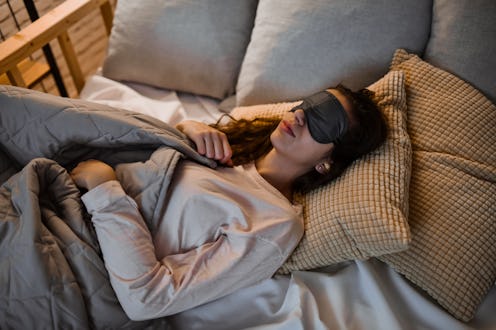Wellness
I Tried The Viral “Sleep Dust” & Saw Impressive Results
You probably already have the ingredients on hand.

Most people keep a collection of odds and ends on their bedside table that helps them fall asleep. You might have a glass of water, lavender spray, a pile of TBR books, and an eye mask, but what you probably don’t have? A mixture of salt and sugar.
This potion — sometimes called “sleepy dust” — is the go-to elixir for many people who randomly wake up at 3 a.m. The idea is to ingest a tiny helping of salt and sugar to sort out your hormones so you can fall back to sleep.
According to Dr. Chelsea Perry, owner of Sleep Solutions and a member of the American Academy of Sleep Medicine, it’s fairly common to wake up around 3 a.m. due to fluctuations in cortisol, which can be higher at night due to stress. For some, blood sugar levels can also be out of whack in the middle of the night. Sleepy dust aims to even out these ups and downs.
“The theory is that sugar provides a quick source of glucose, calming the body's stress response, while salt helps regulate fluids and blood pressure, potentially supporting adrenal function,” she tells Bustle. “Together, these ingredients might help calm the nervous system and promote a more restful sleep.”
To see if it worked for me — a chronic middle-of-the-night waker — I whipped up some sleepy dust, put it in a jar next to my bed, and gave it a try.
How To Make Sleepy Dust
There are quite a few sleepy dust recipes online, and many call for a special type of sugar called Sucanat, which is unrefined sugar cane juice with extra sleep-supporting minerals in it, like calcium, iron, magnesium, and potassium. If you don’t have it or can’t find it, simply use regular cane sugar and sea salt.
- 5 tablespoons organic cane sugar
- 1 tablespoon Sucanat
- 2 teaspoons sea salt
Mix everything and store in a covered jar or bowl by your bed. If you wake up at night, put about a quarter teaspoon or a couple of pinches on or under your tongue and let it melt while you get comfy in bed.
Why Sleepy Dust Works
A tiny pinch of sleepy dust could be just what your body and brain need when your cortisol spikes and wakes you up at 3 a.m.
As Perry says, “Nutrition influences your sleep in several ways, primarily through its impact on blood sugar levels, hormone production, and neurotransmitter function.” If you eat a bunch of sugar or salt right before bed, that can put your cortisol and blood sugar in flux, she says. But a tiny dose in the middle of the night can act as a quick fix, helping you get through the night.
“Taking ‘sleepy dust’ seems to work best around 3 a.m. when hormonal fluctuations like cortisol spikes are more likely to disrupt sleep,” she says. “At this time, the quick hit of glucose from the sugar can calm the body's stress response, while the salt helps regulate adrenal function and blood pressure.”
This isn’t something to rely on forever, Perry says, and it might not work for everyone. But it’s one of those tricks you can keep in your tool bag.
Trying “Sleepy Dust” For Better Sleep
I’ve been so invested in perfecting my bedtime routine. I know to dim the lights and put away my phone. I always make sure my bedroom is cool and dark. I also stick to a sleep schedule as best I can so my circadian rhythm can do its thing.
These factors are relatively easy to control, but you know what isn’t? Waking up at 3 a.m. If this happens to you, too, you know how annoying it is when your eyes pop open in the middle of the night. I’ll often lie awake for an hour or more, and sometimes I’ll feel compelled to get up and have a late-night snack, which could be related to my stress hormones.
What you eat does impact how well you rest, after all, and it’s why other food-related sleep hacks, like the recently viral sleepy girl mocktail, are popular, so it made sense to me that sleepy dust could also be helpful. To give it a try, I hit up my local Whole Foods for ingredients and mixed them together. Easy peasy.
That night, instead of getting up and fumbling in the dark for a bag of pretzels or a cookie, I grabbed a pinch of homemade sleepy dust. While I wasn’t a fan of the taste or the gritty texture, it melted in my mouth fast enough. I let it dissolve and focused on getting comfortable.
I’m not sure if it was the sugar, the salt, or the magical placebo effect that likely kicks in after ingesting something called “sleepy dust,” but I did drift off about 20 minutes later — which is a whole lot faster than usual. I’ve been taking sleepy dust for a week now, and while it doesn’t work 100% of the time, it does seem to take the edge off my middle-of-the-night insomnia.
The Takeaway
While it’s something you’ll want to ask your doctor about before trying, especially if you’re sensitive to sodium, I’d say it’s worth it to have sleepy dust on your bedside table. Perry says it works in a pinch — no pun intended — especially on those nights when nothing else is helping you fall back asleep.
Source:
Dr. Chelsea Perry, owner of Sleep Solutions, member of the American Academy of Sleep Medicine
Studies referenced:
Hirotsu, C. (2015). Interactions between sleep, stress, and metabolism: From physiological to pathological conditions. Sleep Sci. doi: 10.1016/j.slsci.2015.09.002.
Patani, A. (2023). Harnessing the power of nutritional antioxidants against adrenal hormone imbalance-associated oxidative stress. Front Endocrinol (Lausanne). doi: 10.3389/fendo.2023.1271521.